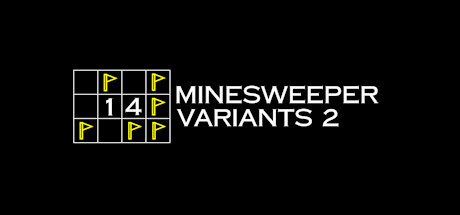Funny minesweeper exccept oh christ it got worse. Now with a new even harder* mode (which was back-ported to the origina, so thats quite nice.)
14 Variants 2 is pretty much the same game as 14 Variants 1, except the variants are all new and different. Everything I’ve said about the first game still holds here too, except for the variants.
Though some variants use the same letters, or even the same name as the original, which only gets a bit confusing. For example, [X] Cross means mines 1 or 2 squares orthagonally from the clue, but [2X] Cross means the clue tells you the number of mines in dark and light tiles (in any order.) It makes more sense when you’re playing, there are examples don’t worry.
Broadly speaking, I’d say this set of variants are, on average, harder than the original, but I don’t know if thats actually the truth, or if I simply have too many neural pathways to the original set of variant logic that I simply haven’t built up for this new set yet.
Anyway, I should actually talk about the different variants in this game.
After the obligatory [V] Vanilla plays, you unlock the first 2 variants. The clue variant [2X] Cross, where every clue has 2 numbers. One tells you the number of mines in light cells, the other in dark cells, but you don’t know which order; and the layout variant [2H] Horizontal, where every mine needs an orthogonally connected partner on the same row.
Then just like in the first game, completing 5 levels of a pattern or clue variant unlocks the next one.
Until you reach the clue variant [2E] Encrypted.
Thats where this game pulls it’s trick.
Suddenly there are 2 grids.
A proper minesweeper grid on the left, and a logic grid on the right, where each cell contains “A=0” to “E=4” (or “H=7”). And on the minesweeper grid, all the clues are replaced by letters.
So you have to figure out what letter corresponds to what clue.
On the second grid, “Clear” corresponds to eliminating an option, and “Flag” corresponds to confirming it. Flagging on the second grid automatically clears all the cells in the same row and column, and chording on the main grid will automatically fill in cells on the second grid (e.g. clicking on an A with only 2 possible cells will clear A=3 and A=4 on the second grid.)
Like in the first game, after you complete all 14 variants, you’ll unlock [2+] which combines a layout rule with a clue rule, but unlike the first game, you also get [2&], which combines one clue rule that doesn’t introduce a second grid, with either [2E] or [2L] Liar. Beating those unlocks [2&+] (combining a layout rule, a clue rule, and a second grid), and [2#] (which combines a second grid with clues that are individually annotated, like in the first game), and finally the final boss [2#+].
Also like the first game, every puzzle is guaranteed to be logically solvable without guessing, and if you are playing in Expert mode, not only is guessing not needed, but becomes completely forbidden, so if you mark any cell that is not logically sound, you will fail.
Whats new is Ultimate mode, though this was backported to the first game a couple weeks before this one released. In ultimate mode, you can see how many cells are logically deducable via a counter in the top right, and any cells you clear are temporarially replaced by “*” until you find all possible clears, at which point you can press the hint button to convert all the *s into clues. You can also enable the modifiers +F/+S to require all possible flags or second grid deductions. This mode is difficult and requires making some logical steps involving more than the maximum 3 clues to make progress before hard mode in some cases, but I personally find it easier than perfect mode (this is the asterisk at the top of the page.) Pro tip: In ultimate mode, the UI is set to whatever colour you are using for mistakes in your colour scheme, so if you change the mistake colour, the UI will change too.
Just like the first game, there is a robust hint system. Using it will tell you what clues to consider, and what cell the clues allow you to deduce. It’s just as important here as it was in the first game as a learning tool, but in this one, it can also be used as an unstuck tool. After staring at the same puzzle grid for 5 minutes, the hint will “charge”, allowing it to be used without breaking the perfect clear star for the level. This can be incredibly helpful when you’re deep into a level, but missing the one last step of logic to finish everything up. In ultimate mode, clicking the hint the first time will tell you which cells can be deduced, but not how, and clicking it again will give you a normal hint for one of those cells.
Steam: https://store.steampowered.com/app/2631960 £5.89 (Demo available)

Leave a Reply